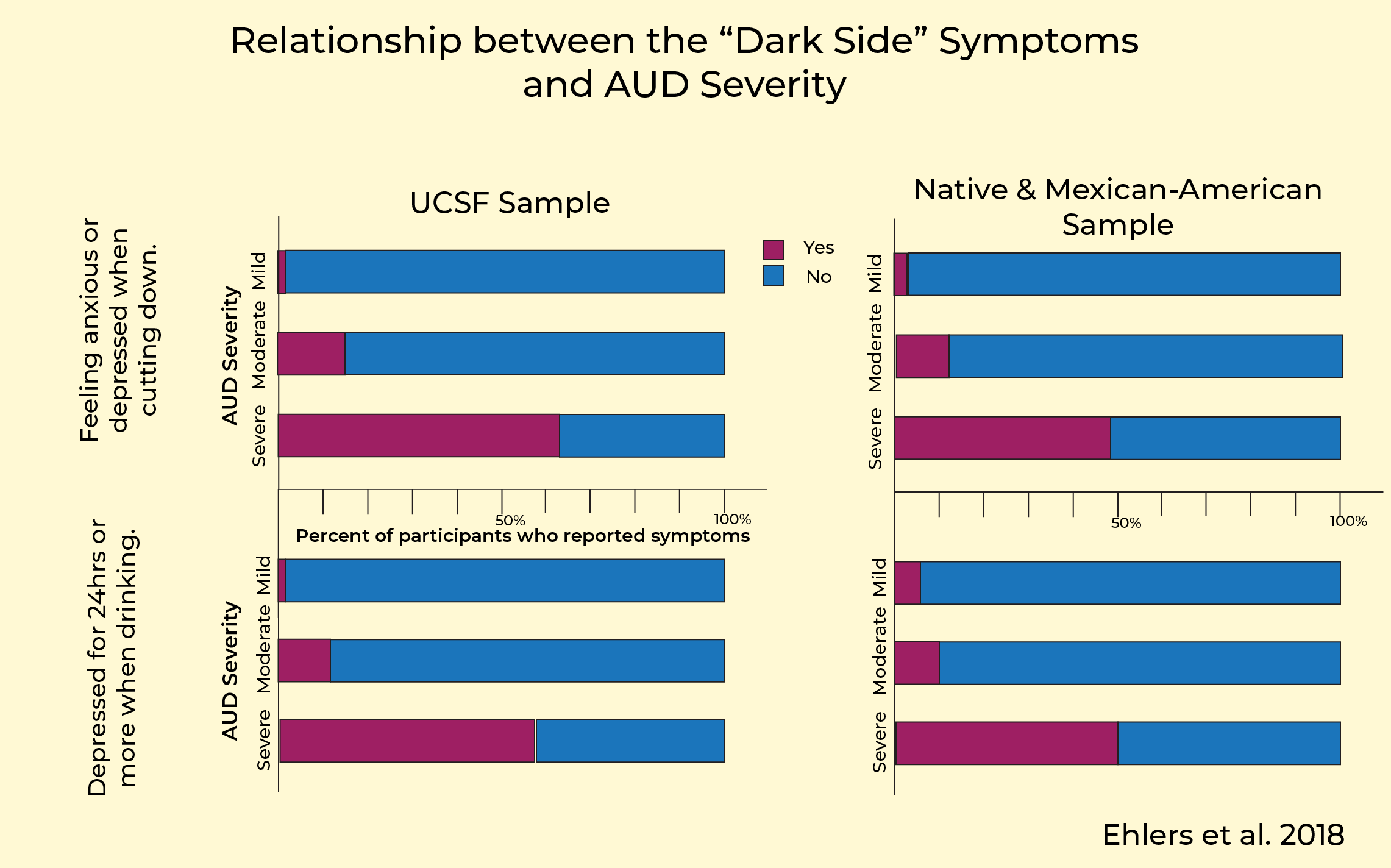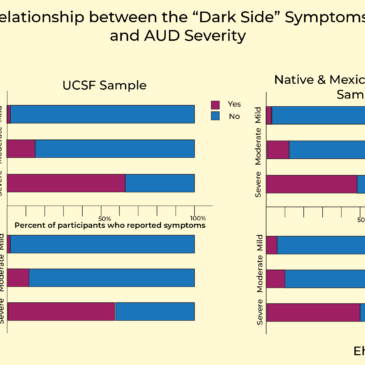Editor's Note: Can you spare five minutes to tell us your thoughts on The BASIS? Your responses to this short questionnaire will help us improve this free resource and better meet your expectations. Thank you!
Individuals with alcohol use disorder (AUD) often experience negative affective “dark side” symptoms, including major depressive episodes and anxiety. Are these symptoms present in all individuals with AUD or only the most severe cases? Cindy L. Ehlers and colleagues explored the relationship between alcohol use disorder and “dark side” negative affective symptoms in depth. We reviewed their study this week.
What was the research question?
What is the relationship between “dark side” negative affective symptoms and the severity of alcohol use disorder (AUD)?
What did the researchers do?
The authors used data from 2,568 participants with AUD from three retrospective cross-sectional studies: a large University of California San Francisco (UCSF) family study that focused on European Americans, a San Diego-based study that focused on Mexican Americans, and a California-based study that focused on six Native American reservations. The Semi-structured Assessment for the Genetics of Alcoholism (SSAGA) was utilized to measure severity of AUD and other alcohol-related problems. Within the SSAGA, participants completed a measure of withdrawal that asked whether they experienced anxiety or depression when they stopped or cut down drinking. They also reported whether their drinking has ever made them feel depressed for more than 24 hours to the point that it interfered with daily functioning.
The authors grouped the Mexican American and Native American groups together for analyses and compared them to the UCSF group. They used logistic regression in order to test the relationship between the “dark side” measures and the severity of AUD, as well as alcohol-related problems.
What did they find?
In the UCSF sample, 61% of participants had experienced anxiety or depression after stopping or cutting down on drinking and 56% of participants experienced 24 hours of depression while drinking that caused disability (i.e., interference with daily functioning). In the combined Mexican American and Native American sample, 23% had experienced anxiety or depression after stopping or cutting down on drinking and 24% had experienced 24 hours of depression while drinking that caused disability.
Participants with severe AUD were more likely than those with low or moderate AUD to report “dark side” symptoms (see Figure). This effect emerged among both the UCSF and Mexican American/Native American samples. Having severe AUD was a predictor of both affective symptoms, but having low or moderate AUD was not. Endorsing the affective symptoms was also associated with suicidal ideations, making plans for suicide, and actual suicide attempts.

Figure. The percent of participants who endorsed “dark side” symptoms by alcohol use disorder severity. Click image to enlarge.
Why do these findings matter?
The co-occurrence of affective disorders among individuals with severe AUD points to a relationship between AUD severity and negative affective symptoms. The question is, are dark side (affective disorder) symptoms indicators of more severe AUD, or is increasing severity of AUD a warning sign for future dark side symptoms? Determining how this relationship works could impact holistic treatment of individuals with AUD, affective disorders, or co-occurrence.
Every study has limitations. What are the limitations in this study?
Although this work was based on three cross-sectional studies, all of the samples came from California. The results may not generalize to groups outside the state. Additionally, the definition of “dark side” symptoms was limited to the authors interpretations of these two specific items available in the SSAGA assessment. It is possible that a different operationalization of “dark side” symptoms — whether based on SSAGA items or something else — would lead to different results. Future studies need to look into a validated and comprehensive assessment instrument for “dark side” affective symptoms.
For more information:
The National Institute for Alcohol Abuse and Alcoholism has tips and resources for people struggling with problem drinking. For drinking self-help tools, please visit The BASIS Addiction Resources page.
Health professionals and addiction specialists have been increasingly focused on mental health as it pertains to COVID-19. They have assembled substance use resources specific to COVID-19-related concerns, as well as resources on alcohol use in general, which can be found on the National Institute on Drug Abuse and Centers for Disease Control and Prevention websites.
— Karen Amichia
What do you think? Please use the comment link below to provide feedback on this article.




